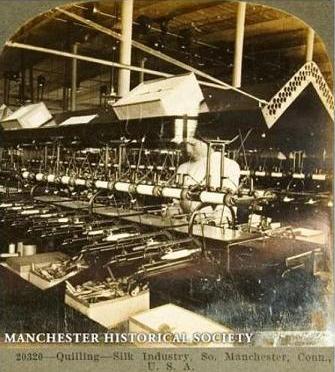



The operation known as "quilling" is illustrated in this view. The quill is a wooden spindle filled with thread. It is placed inside the shuttle in the loom and the thread from it unwinds as the shuttle is thrown back and forth through the warp. The thread which the quill carries is known as the filling. This forms the cross threads or woof of the cloth.
In the picture the quills may be seen, in the lower middle part, being wound with thread from the bobbins above. On the rack at the top is a box of filled quills ready to go into the shuttles.
Of the physical properties of silk, the most striking is that it is a perfect non-conductor of electricity. Silk is also decidedly hygroscopic, that is, it has the property of absorbing water without a feeling or appearance of dampness being noticeable. In fact, silk may in this manner absorb and contain as much as 30 per cent water. One way to detect silk from wool is to apply nitric acid, which dissolves the silk but not the wool. Under the microscope, also, silk is recognizeable by the rod-like appearance of the fibre and its absence of markings. The center or core of silk fibre is known as fibroin. The fibroin, which makes up about two thirds of the fibre, is a substance which is like horn and hair in its chemical properties. The gummy covering of the fibroin is called sericin.
For pictures and contemporary information on the Spinning Mill or 'Clock Tower Mill' in the
"Cheney Brothers National Historic Landmark District" page, click here.

 )
)